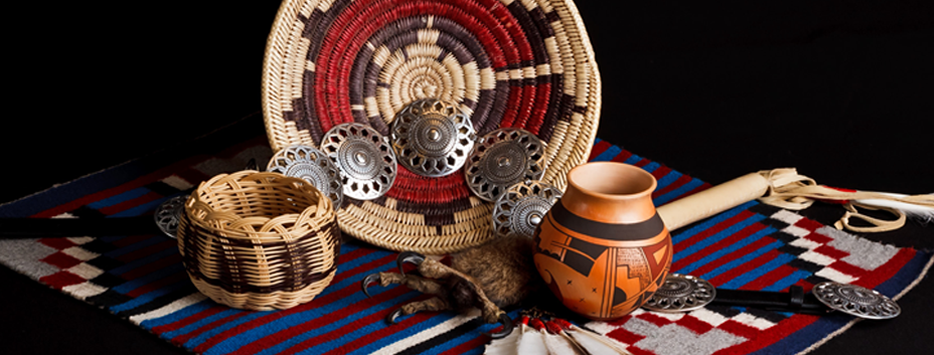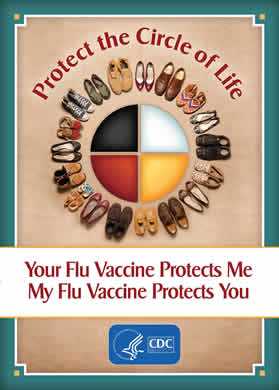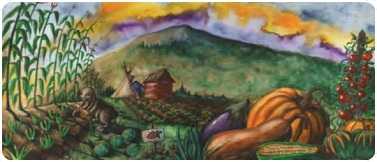American Indian & Alaska Native Contributions to Public Health

Other Contributions?
Do you have another great example of AI/AN contributions to public health? Please share it with us by emailing ostltsfeedback@cdc.gov.
The indigenous people of the Americas—American Indians and Alaska Natives (AI/ANs)—have practiced the art of medicine and wellness for many thousands of years. Therefore, it is no surprise that they have made substantial contributions to public health. This page has been created to honor and bring recognition to these accomplishments.
Lisa Pivec, National Indian Health Board Area Impact Award Recipient
The National Indian Health Board (NIHB) awarded Lisa Pivec, Cherokee Nation’s Senior Director of Public Health, the Area Impact Award for her role in advancing health in Indian Country. NIHB’s 2016 Heroes in Native Health Awards acknowledged individuals and organizations whose work helps improve American Indian and Alaska Native health. NIHB recognized Ms. Pivec during its September 2016 awards ceremony. Under Ms. Pivec’s leadership, Cherokee Nation Health Services became the first tribal public health department in the United States to achieve five-year accreditation status from the Public Health Accreditation Board. Ms. Pivec is a Cherokee Nation citizen and has worked for the Cherokee Nation for more than 25 years.
Alaska’s Community Health Aide Program
Recruited from communities they serve, community health aides are frontline workers, providing preventive and primary health care to America’s diverse communities. Alaska’s Community Health Aide Program has been in operation since the 1950s, and its practitioners are the backbone of rural and frontier health care in Alaska, delivering primary, dental, and behavioral health care. The Alaska Native Tribal Health Consortium, the largest tribal health organization in the United States, manages the statewide medical and public health services of the Alaska Native healthcare system. The effectiveness of care delivery has become a model and is often cited as exemplary.
Development and Worldwide Use of the Hib Conjugate Vaccine
Haemophilus influenzae type b (Hib) is a bacterium that can cause severe infection, mostly in infants and children younger than age 5. The disease can be deadly or cause lifelong disability, and some of the highest rates of Hib disease in history were reported among AI/AN populations. In the 1980s, the Navajo Nation and White Mountain Apache Tribe were instrumental in the development of the Hib conjugate vaccine by participating in clinical trials to study the vaccine’s effectiveness. The vaccine trials were led by Dr. Mathuram Santosham, founder and director for the Center for American Indian Health, and he later received the 2014 John Fries Prize for Improving Health for this research. In his acceptance speech, Dr. Santosham said, “I want to thank the White Mountain Apache and Navajo tribes and all who have worked with us to prove the efficacy of the Hib vaccine and promote its use worldwide.” As a result of this critical contribution, almost every country in the world has made the decision to use the Hib conjugate vaccine. GAVI, an international alliance created to improve access to vaccines for children in poor countries, estimates that by the year 2020, approximately 7 million lives will be saved as a result of the vaccine.
Dr. Susan La Flesche Picotte, First Female Native American Doctor
Born on the Omaha Indian Reservation in 1865, Dr. Susan La Flesche Picotte was the first Native American woman in the United States to become a physician. Dr. Picotte was a noted public health activist, promoting temperance and hygiene on the Omaha Reservation. She cared for both Native Americans and white people during her years of practice, often using her own money to buy treatment supplies when those provided by the Bureau of Indian Affairs ran out. In 1913, just two years before she died, she opened a hospital on the Omaha Reservation.
The “Lakota Grandmas”
The Lakota TB and Health Association originated in 1953 during a tuberculosis outbreak among the Cheyenne River Sioux tribe. The founders were four Lakota grandmothers who took management of the outbreak into their own hands. These women―Phoebe Downing (Standing Rock), Eunice Larrabee (Cheyenne River), Alfreda Janis Bergin (Pine Ridge), and Irene Groneau (Sisseton-Wahpeton)―banded together to serve their tribal health communities by tackling a variety of other health issues, including tuberculosis, mental health, and alcoholism. Their work contributed greatly to the development of the Community Health Representative programs under the Indian Health Service (IHS).
Annie Dodge Wauneka, Presidential Medal of Freedom Winner
Annie Dodge Wauneka, born in 1910, was the first Navajo Nation female elected to serve on the Navajo Tribal Council. She was bestowed the highest civilian honor award, the US Presidential Medal of Freedom, for her lifelong work to integrate cultures, allowing for innovations in medicine to be used on the Navajo Reservation to fight devastating communicable diseases. She was responsible for inaugurating multiple campaigns against influenza, trachoma, tuberculosis, contaminated drinking water, alcoholism, and use of the hallucinogen peyote on the reservation. Among her many contributions was the development of an English-to-Navajo medical dictionary to ensure critical communication around disease prevention and treatment. Ms. Wauneka served on the advisory board to the US Surgeon General and the US Public Health Service, received two honorary doctorates in public health, and was recognized by the Navajo Nation as a “legendary mother of the Navajo people.”
 Susie Walking Bear Yellowtail, “Grandmother of American Indian Nurses”
Susie Walking Bear Yellowtail, “Grandmother of American Indian Nurses”
Born in 1903, orphaned as a child, and raised in a boarding school on the Crow Reservation, Susie Walking Bear Yellowtail became the first registered nurse among the Crow people and also one of the first in the United States. After working with many tribes as a nurse and then returning to work on the Crow Reservation, she began to travel across the country, visiting the reservations as a consultant for the US Public Health Service. She fought against the sterilization of Native American women without informed consent, and she championed the Community Health Representative programs to mitigate language barriers that were affecting the medical care of Native Americans. She was also an appointee on the President’s Council on Indian Education and Nutrition and the US Department of Health, Education, and Welfare’s Council on Indian Health. She received the President’s Award for Outstanding Nursing Health Care, and was named “Grandmother of American Indian Nurses” by her people.
Dr. Everett R. Rhoades, First Native American Director of IHS
Dr. Everett R. Rhoades, MD, a member of the Kiowa Tribe of Oklahoma, was the first Native American director of IHS. During his 11 years in this position, IHS saw its budget allocation from Congress triple, and it built six new hospitals and seven ambulatory care centers across the nation, with additional building underway. There was a substantial increase in ambulatory care services with robust expansion of dental care. Dr. Rhoades also founded the American Association of Indian Physicians, directed the Native American Prevention Research Center, and continues to serve on the Board of the Oklahoma City Indian Clinic and as a lay assistant to the Indian Health Board. A renowned author, Dr. Rhoades has written more than 100 scientific papers.
Koahnic Broadcast Corporation Coverage of Cold and Flu Prevention
During the 2014–2015 influenza season, Koahnic Broadcast Corporation (KBC) in Anchorage, Alaska, helped CDC reach thousands of AI/ANs through its two national programming projects. KBC’s distinguished programs, Native America Calling and National Native News, are broadcast by public and tribal radio stations across the country. KBC’s airing of the Native America Calling “Cold and Flu Season” episode on December 10, 2014, was heard by approximately 148,000 online listeners.
Dr. Patricia Nez Henderson, Public Health Researcher
Dr. Patricia Nez Henderson, a member of the Navajo Nation, was the first American Indian woman to graduate from Yale University School of Medicine and is an important scientist in the field of public health. Dr. Nez Henderson was honored upon graduation with the inaugural Patricia Nez Award developed to recognize graduates committed to improving the health of American Indians. Dr. Nez Henderson serves as vice president for the Black Hills Center for American Indian Health, an American Indian nonprofit organization established in 1998 to address the various health needs of Northern Plains tribes. Dr. Nez Henderson has devoted much of her career to studying the effects of nicotine on Native Americans from a genetic viewpoint, as well as to developing culturally relevant tools for smoking cessation.
 Embracing Traditional Foods to Promote Health
Embracing Traditional Foods to Promote Health
AI/AN communities across the country are reclaiming traditional foods as part of the global indigenous food sovereignty movement that embraces identity, history, and traditional ways and practices to address health. Chelsea Wesner (Choctaw) compiled stories to help the Native Diabetes Wellness Program understand the importance and meaning of traditional foods across Indian Country. The traditional foods stories represent Native communities across Indian Country.
Dr. Jeff Henderson, Founder of the Black Hills Center for American Indian Health
Jeff Henderson, MD, MPH, is a Lakota Indian and enrolled member of the Cheyenne River Sioux tribe of north-central South Dakota. Dr. Henderson founded the Black Hills Center for American Indian Health, whose mission is to enhance the wellness of American Indians through research, service, education, and philanthropy. He serves on the National Advisory Council for CDC’s Breast and Cervical Cancer Early Detection Program. Dr. Henderson is an advocate for the marrying of western and traditional healing practices. He has also extensively studied the impact of traditional food and medicines on Native American health and wellness and has written many articles about the Native voice in healthcare treatment and prevention efforts.
AI/AN Involvement in the National Influenza Vaccination Disparities Partnership
 The National Influenza Vaccination Disparities Partnership is a national campaign spearheaded by local influential partners who commit to promoting the importance of flu vaccination among underserved populations. The partnership has more than 200 AI/AN partners. During the 2014–2015 flu season, AI/AN partners organized 16 flu vaccination promotion events and administered approximately 2,000 flu vaccines, using innovative products to promote flu vaccination among the AI/AN network. The Protect the Circle of Life campaign released 12 new radio public service announcements (featuring Wes Studi, a famous actor and member of the Cherokee Nation) that were aired on 390 stations. This campaign helped generate 2.5 million impressions and incorporated Navajo, Lakota, and Yupik languages to educate Native audiences about the benefits of flu vaccination. A custom web page was also developed to promote the AI/AN Flu IQ quiz, and an infographic was developed to capture key messages and data that speak to the importance of annual flu vaccination in Indian Country.
The National Influenza Vaccination Disparities Partnership is a national campaign spearheaded by local influential partners who commit to promoting the importance of flu vaccination among underserved populations. The partnership has more than 200 AI/AN partners. During the 2014–2015 flu season, AI/AN partners organized 16 flu vaccination promotion events and administered approximately 2,000 flu vaccines, using innovative products to promote flu vaccination among the AI/AN network. The Protect the Circle of Life campaign released 12 new radio public service announcements (featuring Wes Studi, a famous actor and member of the Cherokee Nation) that were aired on 390 stations. This campaign helped generate 2.5 million impressions and incorporated Navajo, Lakota, and Yupik languages to educate Native audiences about the benefits of flu vaccination. A custom web page was also developed to promote the AI/AN Flu IQ quiz, and an infographic was developed to capture key messages and data that speak to the importance of annual flu vaccination in Indian Country.
Responding to the Sin Nombre Virus Outbreak
In 1993, the CDC Special Pathogens Branch, the state health departments of New Mexico, Colorado, and Utah, IHS, the Navajo Nation, and the University of New Mexico all joined together to confront an outbreak of a newly discovered virus. It was called Sin Nombre virus, and the disease caused by the virus was named hantavirus pulmonary syndrome. The isolation of the virus in a matter of months was remarkable. This success was a result of close cooperation of the agencies and individuals involved in investigating the outbreak, years of basic research on other hantaviruses by CDC and the US Army Medical Research Institute of Infectious Diseases, and the continuing development of modern molecular virologic tests.
Collaborating with CDC to Create Tribal Health Success Stories
The Association of American Indian Physicians (AAIP) has partnered with CDC’s Office for State, Tribal, Local and Territorial Support, CDC’s National Center for Chronic Disease Prevention and Health Promotion, and tribal communities to gather a compendium of evidence-based, culturally appropriate tribal health success stories for tribal health departments, tribes, AI/AN organizations, AAIP members, government agencies, and other partners. Tribes highlighted include Mashantucket Pequot for Reclaiming Public Health, Umatilla for Bounc’N Cancer, Yankton Sioux for Preventing Diabetes in Future Generations of At-Risk Youth, Akwesasne/St. Regis Mohawk for The Family as a Thinking Body, and the American Indian Cancer Foundation for Cancer Solutions Based on Community Wisdom.
- Page last reviewed: December 9, 2016
- Page last updated: December 9, 2016
- Content source:


 ShareCompartir
ShareCompartir



